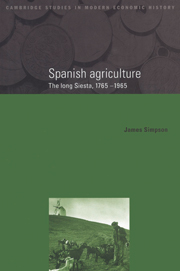Book contents
- Frontmatter
- Contents
- List of illustrations
- List of tables
- Acknowledgements
- Note on the regional division of Spain
- Abbreviations and conventions
- Introduction
- Part I The relative backwardness of Spanish agriculture
- 1 Spanish agriculture: the long view
- 2 Unlocking the puzzle of stagnation: regional variations
- Part II Traditional technologies and market opportunities, 1765–1880
- Part III The limits to technical change, 1880–1936
- Part IV Markets and institutions, 1880–1936
- Part V The State and the end of traditional agriculture
- Conclusion
- Appendix Estimates of agricultural output and consumption in nineteenth-century Spain
- Bibliography
- Index
2 - Unlocking the puzzle of stagnation: regional variations
Published online by Cambridge University Press: 04 December 2009
- Frontmatter
- Contents
- List of illustrations
- List of tables
- Acknowledgements
- Note on the regional division of Spain
- Abbreviations and conventions
- Introduction
- Part I The relative backwardness of Spanish agriculture
- 1 Spanish agriculture: the long view
- 2 Unlocking the puzzle of stagnation: regional variations
- Part II Traditional technologies and market opportunities, 1765–1880
- Part III The limits to technical change, 1880–1936
- Part IV Markets and institutions, 1880–1936
- Part V The State and the end of traditional agriculture
- Conclusion
- Appendix Estimates of agricultural output and consumption in nineteenth-century Spain
- Bibliography
- Index
Summary
Contemporaries provided a number of explanations for the poor performance of Spanish agriculture described in chapter I, with unfavourable topography, poor soils, inclement climate and an ‘inefficient’ property distribution being the most frequently cited. This chapter is divided into three sections. In the first, I examine some of the consequences of resource endowments. In particular, the presence of summer drought over much of the Peninsula meant that dryfarming methods were used, and livestock densities were low. In the second section, I look at land distribution and tenurial systems and identify major differences within the country. Finally, I explore what regional variations can tell us about the problem of backwardness. To do this, I have divided the country into four agricultural areas (see pp. xvii–xix): the North (Galicia, Asturias, Santander and the two maritime provinces of the Basque Country, Guipúzcoa and Vizcaya); the Mediterranean coastal areas (Cataluña minus Lleida, the Baleares, the País Valenciano and Murcia); Andalucía (the eight provinces), and the rest which I call the Interior. It is argued that three factors explain the different regional performances: the predominance of low value, extensive cereal and legume rotations using excessive quantities of labour; the relatively small areas of high value crops such as fruit trees, sugar beet, market gardening, which maximised land output; and, finally, the small scale of intensive dairy and meat production.
- Type
- Chapter
- Information
- Spanish AgricultureThe Long Siesta, 1765–1965, pp. 33 - 58Publisher: Cambridge University PressPrint publication year: 1996



